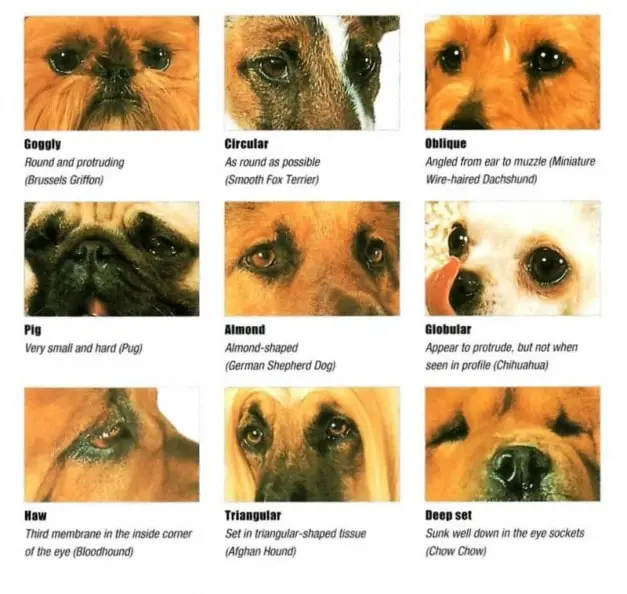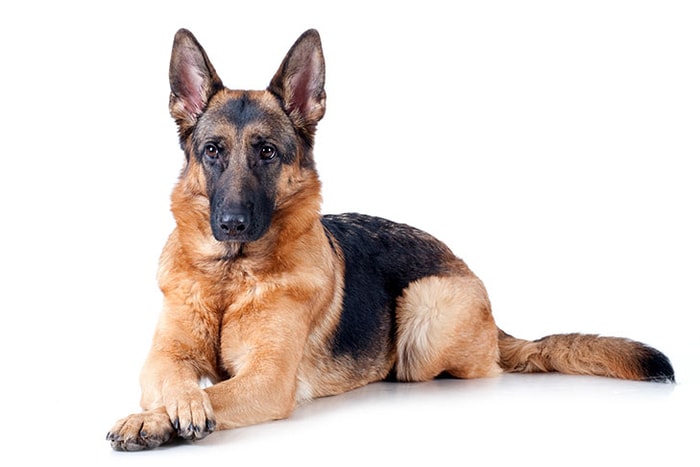The dog eyes are uniquely adapted to a dog’s needs. The spherical dog eyes are set in bony sockets and cushioned by a layer of adipose tissue. The eyes are placed on the front of the face rather than to the side of some animals. You must be surprised to know these dogs have excellent night vision, good depth perception, and a total visual field of 250 degrees. These are all essential criteria for an animal that evolved as a predator.
The eyes allow the dog’s visual field to overlap and increase his ability to judge depth and perceive detail. The terminology for dog eyes is based on the shape and how the eyes are set in the orbital cavity. The position in the orbital cavity affects the dog’s field of vision.
The Anatomy of Dog Eyes
The parts of the eyes begin with the cornea, the transparent outer coating. The conjunctiva is the pinkish covering of the eye membrane with blood vessels and nerve supply. The sclera is the connective tissue that surrounds the conjunctiva. The sclera supports the eyeball or globe. The pupil is in the center, is a dark and round opening through which light enters the eyes’ lens.

The retina or nervous layer of the eye is a sensitive inner lining with abundant rod cells to detect light and a smaller number of cone cells to distinguish among colors. The iris is located behind the cornea that is a pigmented structure. The iris expands and constricts that regulates the amount of light that enters the eyes. The color of the eyes is also regulated or determined by the color of the iris. The iris converts the light into electric impulses and transmits the light into the brain through the optic nerve. The brain center reads the electric impulse to create the actual images.

Dog Eyes: Surprising Points For Owner
Your lovely dogs have eye structures which don’t you know:
Third eyelid: supporting the front of the eye are tight skin folds, the eyelids. Unlike people, dogs have third eyelids, the nictitating membrane, at the inner corner of the eye. This membrane stays typically retracted, but it can cover the eye for protection if necessary. The third eyelid looks as if the eyes have rolled back into the head when this happens.

Tears: The tears are secreted by the lachrymal glands of the eyes. Tears collect at the corner of the eye and are then carried along the nasolacrimal ducts into the nasal cavity. The lacrimal secretion keeps the cornea moist and contains immune substances that help fight infections. When tears aren’t carried away, they can stain the fur beneath a dog’s eye.
Most Common Types of Dogs Eyes
You will be more surprised to know the types of dog eyes. So far, you heard only the eyes and structures. There are numerous types of dog eyes. The types of eyes are essential tools for identifying dog breeds and types. Here, I will mention the most common types of dog eyes.
1. Googly Eyes: The eyes are round and protruding. Example: Brussels Griffon.

2. Circular Eyes: The eyes are as round as possible. Example: Smooth Fox Terrier.

3. Oblique Eyes: These eyes angled from ear to muzzle. Example: Miniature Wire-haired Dachshund.

4. Pig Eyes: The eyes are tiny and hard. Example: Pug Dogs.

5. Almond-Shaped Dog Eyes: These eyes are almond-shaped.Example: German Shepherd.

6. Globular Eyes: The eyes appear to protrude, but not when seen in profile. Example: Chihuahua.

7. Haw Eyes: Third membrane in the inside corner of the eye. Example: Bloodhound.

8. Triangular Eyes: The eyes are set in triangular-shaped tissue. Example: Afghan Hound.

9. Deep-set Eyes: The eyes are sunk well down in the eye sockets. Example: Chow Chow

Sign of Eye Problems and Diseases
You must identify the healthy eyes from the diseased eyes of your lovely pet. The most common signs of illness of dog eyes are as follows. You must inform your vet immediately if any signs are present in your pet.
- Tearing.
- Squinting.
- Sensitivity to light.
- A teary or mucous discharge.
- A dark or cloudy eye.
- Swelling.
- Crusting.
- Itching.
- Bulging or sunken eye.
- Conjunctivitis.
- Keratitis.
- Keratoconjunctivitis.
- Redness.
- Swelling of eyes.

Common Eye Problems of Dogs
Many eye problems can affect dogs. These include:
- Trapped foreign bodies such as seeds, dirt, or other debris
- Entropian
- Ecotopian
- Conjunctivitis in dogs.
- Dry eye.
- Corneal abrasions or ulcers
- Cataracts in dogs.
- Glaucoma in dogs.
- Progressive retinal atrophy.
- Keratoconjunctivitis.
- Tumors or neoplasia
Final Talk on Dog Eyes
The eyes are the essential organs of an animal. The dog eyes serve many vital roles during identification, choice of breed, working ability, and personality. In my article, I have tried to give all crucial points on dog eyes, structure, abnormal signs, eye diseases, and common types of eyes. I think this article is full of new information for you. Thank you very much again for your kind patience in reading.
If you like this article, please share it with friends.